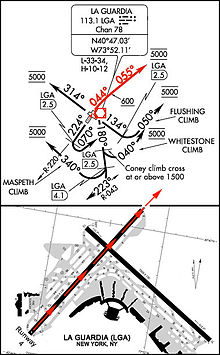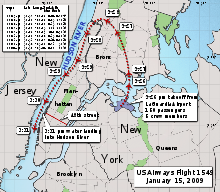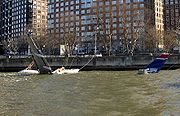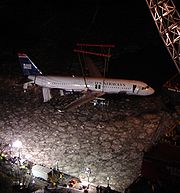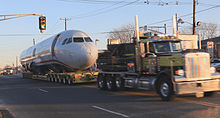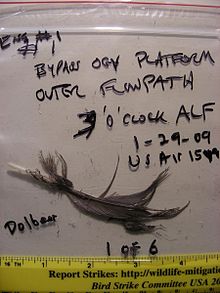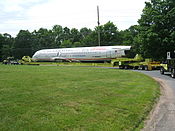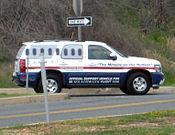- US Airways Flight 1549
-
US Airways Flight 1549 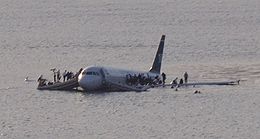
The downed US Airways Flight 1549 floating on the Hudson RiverAccident summary Date January 15, 2009 Type Multiple bird strikes, controlled ditching Site In the Hudson River between New York City (near 48th Street) and Weehawken, New Jersey (near Port Imperial), United States
40°46′10″N 74°00′17″W / 40.769498°N 74.004636°WCoordinates: 40°46′10″N 74°00′17″W / 40.769498°N 74.004636°WPassengers 150[1] Crew 5 Injuries 2 (serious) / 3 (minor) Fatalities 0 Survivors 155 (all) Aircraft type Airbus A320-214 Operator US Airways Tail number N106US Flight origin LaGuardia Airport, New York City Stopover Charlotte/Douglas International Airport Destination Seattle–Tacoma International Airport US Airways Flight 1549 was US Airways' scheduled domestic commercial passenger flight from LaGuardia Airport in New York City to Charlotte/Douglas International Airport, Charlotte, North Carolina. On January 15, 2009, the aircraft flying this route, an Airbus A320-214, was successfully ditched in the Hudson River adjacent to midtown Manhattan six minutes after takeoff from LaGuardia Airport after being disabled by striking a flock of Canada geese during its initial climb out. The incident became known as the "Miracle On The Hudson".[2][3][4]
The bird strike, which occurred just northeast of the George Washington Bridge about three minutes into the flight, resulted in an immediate and complete loss of thrust from both engines. When the crew of the aircraft determined that they would be unable to reliably reach any airfield, they turned southbound and glided over the Hudson, finally ditching the airliner near the USS Intrepid museum about three minutes after losing power. All 155 occupants safely evacuated the airliner, which was still virtually intact though partially submerged and slowly sinking, and were quickly rescued by nearby ferries and other watercraft. [5][6][7][8]
The entire crew of Flight 1549 was later awarded the Master's Medal of the Guild of Air Pilots and Air Navigators. The award citation read, "This emergency ditching and evacuation, with the loss of no lives, is a heroic and unique aviation achievement."[9] It has been described as "the most successful ditching in aviation history."[10]
Flight designations, route, and crew
US Airways Flight 1549 (also designated under a Star Alliance codeshare agreement as United Airlines Flight 1919) was a domestic route from New York City's LaGuardia Airport (LGA) to Charlotte/Douglas (CLT), North Carolina, with direct onward service to Seattle–Tacoma International Airport in Washington.
On January 15, 2009, the flight was cleared for takeoff from Runway 4 at LaGuardia at 3:24:56 p.m. EST (20:24:56 UTC). The crew made its first report after becoming airborne at 3:25:51 as being at 700 feet (210 m) and climbing.[11] There were 150 passengers and five crew members, including the captain, first officer, and three flight attendants, on board.[1][12]
The pilot in command was 57-year-old Capt. Chesley B. "Sully" Sullenberger, a former fighter pilot who had been an airline pilot since leaving the United States Air Force in 1980. He is also a safety expert and a glider pilot.[13][14][15][16][17] The first officer was Jeffrey B. Skiles, 49,[15][18][19] who was on the last leg of his first assignment in the Airbus A320 since passing the training course to fly the type.[20] The flight attendants were Donna Dent,[21] Doreen Welsh and Sheila Dail.[22]
As is often the case when a regularly scheduled commercial flight is involved in an accident, use of the flight's number, 1549, was discontinued for subsequent operations of the carrier's afternoon LGA–CLT–SEA service. On January 16, 2009, the route was redesignated US Airways Flight 1543, and on February 12, 2009, the LGA–CLT leg became Flight 1867 when its equipment was changed to an Airbus A321.[23]
Airbus A320-214
The aircraft was an Airbus A320-214 (registration N106US), powered by two GE Aviation/Snecma-designed CFM56-5B4/P turbofan engines manufactured in France and the U.S.[24] One of 74 A320s then in service in the US Airways fleet,[25] it was built by Airbus with final assembly at its facility at Aéroport de Toulouse-Blagnac in France in June, 1999. Delivered to the carrier on August 2, 1999, the airliner was registered to Wells Fargo Bank Northwest, NA, as owner/lessor[26] with AIG listed as the lead insurer.[27]
The aircraft's FAA-required maintenance records,[28] released by US Airways the day after the accident, showed that when N106US was written off, its airframe had logged 16,299 cycles (flights) totaling 25,241.08 flight hours. Total time on the engines was 19,182 hours on the left (#1) and 26,466 hours on the right (#2). The last A Check, a maintenance check performed every 550 flight hours, was passed on December 6, 2008, and the last C Check (annual comprehensive inspection) on April 19, 2008.[24][29]
The Airbus A320 is a digital fly-by-wire aircraft: the flight control surfaces are moved by electrical and hydraulic actuators controlled by a digital computer. The computer interprets pilot commands via input from a side-stick, making adjustments on its own to keep the plane stable and on course, which is particularly useful after engine failure by allowing the pilots to concentrate on engine restart and landing planning.[30]
The mechanical energy of the two engines is the primary source of routine electrical power and hydraulic pressure for the aircraft flight control systems.[31] The aircraft also has an auxiliary power unit (APU), which can provide backup electrical power for the aircraft, including its electrically powered hydraulic pumps; and a ram air turbine (RAT), a type of wind turbine that can be deployed into the airstream to provide backup hydraulic pressure and electrical power at certain speeds.[31] According to the NTSB, both the APU and the RAT were operating as the plane descended into the Hudson, although it was not clear whether the RAT had been deployed manually or automatically.[31]
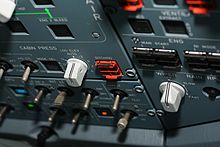 Ditching button (the central square orange area) on the overhead panel of an Airbus A330.
Ditching button (the central square orange area) on the overhead panel of an Airbus A330.
The Airbus A320 has a "ditching" button that closes valves and openings underneath the aircraft, including the outflow valve, the air inlet for the emergency RAT, the avionics inlet, the extract valve, and the flow control valve. It is meant to slow flooding in a water landing.[32] The flight crew did not activate the "ditch switch" during the incident.[33] Sullenberger later noted that it probably would not have been effective anyway, since the force of the water impact tore holes in the plane's fuselage much larger than the openings sealed by the switch.[20]
Flight
Take off and bird strike
First Officer Skiles was at the controls of the flight when it took off to the northeast from Runway 4 at 3:25 p.m., and was the first to notice a formation of birds approaching the aircraft about two minutes later, while passing through an altitude of about 2,700 feet (820 m)[2] on the initial climb out to 15,000 feet (4,600 m). According to FDR data, the bird encounter occurred when the airplane was at an altitude of 2,818 feet above ground level (agl) and a distance of about 4.5 miles north-northwest of the approach end of runway 22 at LGA. Subsequently, the airplane’s altitude continued to increase while the airspeed decreased, until 3:27:30, when the airplane reached its highest altitude of about 3,060 feet (930 m) at an airspeed of about 185 kts calibrated airspeed (KCAS) The altitude then started to decrease as the airspeed started to increase, reaching 210 KCAS at 3:28:10 at an altitude of about 1,650 feet (500 m) The windscreen quickly turned dark brown and several loud thuds were heard. Capt. Sullenberger took the controls, while Skiles began going through the three-page emergency procedures checklist in an attempt to restart the engines.[34]
At 3:27:36, using the call sign "Cactus 1539" [sic],[35] the flight radioed air traffic controllers at New York Terminal Radar Approach Control (TRACON)[36] "Hit birds. We've lost thrust on both engines. We're turning back towards LaGuardia." Passengers and cabin crew later reported hearing "very loud bangs" in both engines and seeing flaming exhaust, then silence from the engines and smelling the odor of unburned fuel in the cabin.[5][37][38] Responding to the captain's report of a bird strike, controller Patrick Harten, who was working the departure position [39] told LaGuardia tower to hold all waiting departures on the ground, and gave Flight 1549 a heading to return to LaGuardia and told him that he could land to the southeast on Runway 13.[36] Sullenberger responded that he was unable.[36]
Sullenberger asked if they could attempt an emergency landing in New Jersey, mentioning Teterboro Airport in Bergen County as a possibility;[36][40][41] air traffic controllers quickly contacted Teterboro and gained permission for a landing on runway 1.[40] However, Sullenberger told controllers that "We can't do it", and that "We're gonna be in the Hudson", making clear his intention to bring the plane down on the Hudson River due to a lack of altitude.[42] Air traffic control at LaGuardia reported seeing the aircraft pass less than 900 feet (270 m) above the George Washington Bridge.[43] About 90 seconds before touchdown, the captain announced, "Brace for impact",[43] and the flight attendants instructed the passengers how to do so.[44]
Ditching
The plane ended its six-minute flight at 3:31 pm with an unpowered ditching while heading south at about 130 knots (150 mph; 240 km/h) in the middle of the North River section of the Hudson River roughly abeam 50th Street (near the Intrepid Sea-Air-Space Museum) in Manhattan and Port Imperial in Weehawken, New Jersey. Sullenberger said in an interview on CBS television that his training prompted him to choose a ditching location near operating boats so as to maximize the chance of rescue. The location was near three boat terminals: two used by ferry operator NY Waterway on either side of the Hudson River and a third used by tour boat operator Circle Line Sightseeing Cruises.[11][45] The ditching location was approximately 40°46′10″N 74°00′17″W / 40.769498°N 74.004636°W.[46] After coming to a stop in the river, the plane began drifting southward with the current.[47]
National Transportation Safety Board (NTSB) Board Member Kitty Higgins, the principal spokesperson for the on-scene investigation, said at a press conference the day after the accident that it "has to go down [as] the most successful ditching in aviation history."[10] "These people knew what they were supposed to do and they did it and as a result, nobody lost their life."[48]
Evacuation
Coast Guard video (8:07 long) of the crash and rescue; splashdown is at 3:31:02 pm
Immediately after the A320 had been ditched in mid-river, Sullenberger gave the "evacuate" order over the PA, and the aircrew began evacuating the 150 passengers, both on to the wings through the four mid-cabin emergency window exits and into an inflatable slide that doubles as a life raft, deployed from the front right passenger door (the front left slide failed to operate as intended), while the partially submerged and slowly sinking airliner drifted down the river with the current. Two flight attendants were in the front, one in the rear. Each flight attendant in the front opened a door, which was also armed to activate a slide/raft, although the port side raft did not immediately deploy; a manual inflation handle was pulled. One rear door was opened by a panicking passenger, causing the A320 to fill more quickly with water. The flight attendant in the rear who attempted to reseal the rear door was unable to do so, she told CBS News.[49] It was later revealed that the impact with the water had ripped open a hole in the underside of the airplane and twisted the fuselage, causing cargo doors to pop open and filling the plane with water from the rear.[50] The flight attendant urged passengers to move forward by climbing over seats to escape the rising water within the cabin. One passenger was in a wheelchair. Having twice walked the length of the cabin to confirm that no one remained inside after the plane had been evacuated, the captain was the last person to leave the aircraft.[45][51][52][53]
Evacuees, some wearing life-vests, waited for rescue on the partly submerged slides, knee-deep in icy river water. Others stood on the wings or, fearing an explosion, swam away from the plane.[49] Air temperature at the time was about 20 °F (−7 °C), and the water was 36 °F (2 °C).[41]
Rescue
Video from 20 minutes after ditching, with numerous ferries and rescue boats surrounding the aircraft
Local commercial vessels from the NY Waterway and Circle Line Sightseeing Cruises fleets responded almost immediately to the emergency. NY Waterway ferry Thomas Jefferson, commanded by Captain Vincent Lombardi, was first on the scene arriving at the side of the plane just four minutes after the ditching. NY Waterway ferry Governor Thomas H. Kean, under the command of 20-year-old Captain Brittany Catanzaro,[54] was the second rescue craft to arrive reaching the plane a few minutes later.[55] Catanzaro reported to radio station WNYC that she and her crew used a Jason's cradle to bring people who were wet onto her boat. Aircraft captain Sullenberger stated in CBS News interviews that he advised the ferry crew to rescue passengers on the wing before the passengers in the inflatable slides, as the inflatable slides provided a higher level of safety. Time-stamped video from a United States Coast Guard (USCG) surveillance camera shows that the first of these vessels, a ferry boat, reached the plane at 3:35 pm (four minutes after the ditching) and began rescuing the 155 occupants. By this time many passengers were already standing on the wings or in the inflated slides.[52] The slides eventually detached from the fuselage to form life rafts.[43] At one point, as the plane moved in the strong ebb tide current, passengers on one of the slides, fearing that the stern of the ferry boat would crush them, had to shout to the ferry boat pilot to steer away.[56]
Within minutes,[57] vessels from the New York City Fire and Police Departments (FDNY and NYPD), the USCG,[58] and a privately owned former Coast Guard Buoy Tender were on scene to help with the rescue and recovery effort.[59] All of the passengers and flight crew were rescued safely.[43]
The FDNY sent four marine units and rescue divers.[60] On land, FDNY declared a level III (All Hands) emergency and mobilized their Major Emergency Response Vehicle, Logistical Support Units and had 35 ambulances ready for patients coming off the flight.[61][62] About 140 FDNY firefighters responded to docks near the crash.[60] The NYPD sent squad cars, helicopters, vessels, and rescue divers from the Aviation Unit and Harbor Unit.
In addition, about 30 other ambulances were made available by other organizations, including several hospital-based ambulances (St. Vincent, St. Barnabas). Various agencies also provided medical help on the Weehawken side of the river, where most passengers were taken.[63] Two mutual aid helicopters responded to the West 30th Street Heliport, one from the Nassau County Police and another from the New Jersey State Police.[64] New York Water Taxi sent boats to the scene but did not take part in the rescue.[65]
Injuries
There were five serious injuries,[66] one of which was a deep laceration in flight attendant Doreen Welsh's leg.[33][67] In total, 78 people were treated, mostly for minor injuries[68] and hypothermia.[69]
Hospitals that treated patients include Saint Vincent's Catholic Medical Center in Greenwich Village; St. Luke's-Roosevelt Hospital Center, which admitted ten people; New York Downtown Hospital, which treated three passengers; and Palisades Medical Center in North Bergen, New Jersey, which treated five patients for hypothermia.[70] In all, 24 passengers and two rescue personnel were treated at hospitals,[71] while others were cared for in triage facilities.[43] According to the airline, no pets were being transported in the cargo hold, with a spokesperson stating, "We don't carry pets in our cargo."[72]
Delayed psychological effects were experienced as a result of the accident and rescue. Symptoms of post-traumatic stress including sleeplessness, flashbacks, and panic attacks were reported by members of the aircrew, passengers, and others directly involved. A number of the survivors received professional counseling, and some began an email support group to help ease the aftereffects of the experience.[73] In addition to those on the plane, FAA Air Traffic Control Specialist Patrick Harten, the New York TRACON controller who worked the flight during the emergency, later stated in testimony before Congress that for him "the hardest, most traumatic part of the entire event was when it was over" during which he was continually "gripped by raw moments of shock and grief."[74]
Aftermath
Tied up alongside Battery Park CityThe downed A320 being recovered from the Hudson River during the night of January 17.At 4:57 p.m. fire crews began to stand down. At 5:07 p.m. Doug Parker, CEO of US Airways, issued an official statement during a press conference in Tempe, Arizona, in which he confirmed that the flight had been involved in an accident.[75]
The flight crew, particularly Captain Sullenberger, were widely praised for their actions during the incident, notably by New York City Mayor Michael Bloomberg and New York State Governor David Paterson, who opined, "We had a Miracle on 34th Street. I believe now we have had a Miracle on the Hudson."[68][76][77] Outgoing U.S. President George W. Bush said he was "inspired by the skill and heroism of the flight crew", and he also praised the emergency responders and volunteers.[78] Then President-elect Barack Obama said that everyone was proud of Sullenberger's "heroic and graceful job in landing the damaged aircraft", and thanked the A320's crew, whom he invited to attend his inauguration as President in Washington, D.C., five days later. He also invited those who had helped ensure the safety of all 155 people aboard.[79][80]
Following the rescue, the Airbus A320 remained afloat, though partially submerged, and was quickly moored to a pier near the World Financial Center in Lower Manhattan, roughly 4 miles (6 km) downstream from where it had ditched.[44] The left engine had detached from the aircraft during the ditching and was recovered several days later from the river bottom, 65 feet (20 m) below the surface.[81] The water was so murky that the right engine was initially thought to have also detached, but it was later found to be still in place on the aircraft (with much of its nacelle missing).[82] On January 17, the aircraft was removed from the Hudson River and placed on a barge.[83][84] The aircraft was then moved to New Jersey for examination.[85]
The method used to recover the submerged airframe from the water rendered it uneconomical to repair and the airliner was written off.[86] The rear pressure bulkhead was also damaged in the accident, and the salvage contractor, Weeks Marine, cut off the wings and empennage. Another salvage contractor, Source One Airplane Repair, contends that if due care had been taken during the recovery, the aircraft could have been repaired for $20,000,000 (less than a third of the cost of a new aircraft).[87]
The passengers on the aircraft each received a letter of apology, $5,000 in compensation for lost baggage, or $5,000 more if passengers can demonstrate more than $5,000 in losses, and a refund of the ticket price.[88][89] Beginning in May 2009, passengers received their baggage and other belongings. In addition, passengers reported they were offered $10,000 each not to sue US Airways for damages by American International Group (AIG), the airline's insurance carrier.[90]
To prevent similar incidents, workers from the United States Department of Agriculture Wildlife Services and the city’s Parks and Recreation Department and Environmental Protection Departments descended on 17 locations across New York capturing and gassing 1,235 Canada Geese in June and July 2009.[91] The Agriculture Department undertook another goose control measure by coating 1,739 eggs with corn oil, which prevents goslings from developing by depriving them of air.[91]
On January 21, 2010, it was announced that the plane involved in the crash would be auctioned off "as-is where-is." The engines were not included in the auction, and it was noted that the fuselage has major water and impact damage.[92] The Carolinas Aviation Museum in Charlotte, North Carolina has taken possession of the plane (see below).
Accident investigation
Shortly after the event, Federal Aviation Administration (FAA) spokeswoman Laura Brown said that the plane may have been hit by birds.[93] A National Transportation Safety Board (NTSB) Go Team (typically comprising specialists in fields relating to the incident), led by Senior Air Safety Investigator Robert Benzon, was dispatched to New York.[94] The preliminary report of the incident, published on January 16, states that the aircraft went down following a bird strike.[95] This conclusion, and the simultaneous loss of thrust in both engines, was confirmed by preliminary analysis of the Cockpit Voice Recorder and the Flight Data Recorder, both of which were recovered by the NTSB when the aircraft was lifted out of the river on January 18.[48]
The next day, reports surfaced that the same airplane and same flight had experienced a similar but less severe compressor stall on January 13. During that flight, passengers were told they might have to make an emergency landing.[96][97] However, the affected engine was restarted and the flight continued to Charlotte. The NTSB later reported that this engine surge had been caused by a faulty temperature sensor, which was replaced, and that the engine was undamaged by the event, which allowed the plane to return to service.[98]
On January 21, the NTSB noted that organic debris, including a single feather, as well as evidence of soft-body damage, was found in the right engine.[99][100] The left engine was recovered from the river on January 23 and, like the right engine, was missing a large portion of its housing.[101] On initial examination the NTSB reported that while missing obvious organic matter, it too had evidence of soft body impact, and "had dents on both the spinner and inlet lip of the engine cowling. Five booster inlet guide vanes are fractured and eight outlet guide vanes are missing." Both engines were to be sent to the manufacturer's Cincinnati, Ohio, facility for teardown and examination.[102] On January 31, the plane was moved to a secure storage facility in Kearny, New Jersey, for the remainder of the investigation. The NTSB confirmed that bird remains had been found in both engines.[98][103] The bird debris was later identified, through DNA testing, as the remains of Canada Geese, the typical weights of which are well above the limits of impact for which the engines were designed.[98]
On February 5, the FAA released audio tape recordings and transcripts of its internal and broadcast ATC communications relating to the accident. The entire exchange between Flight 1549 and air traffic control relating to the emergency lasted less than two minutes.
The A320 had been assembled by the Airbus Division of the European aerospace consortium EADS, at the Airbus headquarters manufacturing facilities in Toulouse, France, therefore, under the provisions of ICAO Annex 13,[104] both the European Aviation Safety Agency (the European counterpart of the FAA) and the Bureau d'Enquêtes et d'Analyses pour la sécurité de l'Aviation Civile (the French counterpart of the NTSB) became active participants in the accident investigation, with technical assistance provided by Airbus Industrie and GE Aviation/Snecma as manufacturers of the airframe and engines respectively.[105][106]
The NTSB ran a series of tests using Airbus simulators in France, to see if Flight 1549 could have returned safely to LaGuardia. The simulation started immediately following the bird strike and "...knowing in advance that they were going to suffer a bird strike and that the engines could not be restarted, four out of four pilots were able to turn the A320 back to LaGuardia and land on Runway 13."[107] When the NTSB later imposed a 30 second delay before they could respond, in recognition that it wasn't reasonable to expect a pilot to assess the situation and react instantly, all four pilots crashed.[108]
Flight 1549 is the fifth take-off/departure phase accident at LaGuardia resulting in the write off of an airframe for a commercial air carrier since the field opened in 1939.[109] Of those, it is the third involving the hull loss of a US Airways/USAir plane.[110][111]
On May 4, 2010, the NTSB released a statement which credited the accident outcome to the fact that the aircraft was carrying safety equipment in excess of that mandated for the flight, and excellent cockpit resource management among the flight crew. Contributing factors were the good visibility and fast response from the various ferry operators. Captain Sullenberger's decision to ditch in the Hudson River was validated by the NTSB.[112]
On May 28, 2010, the NTSB published its final report into the accident. It determined the probable cause of the accident to be "the ingestion of large birds into each engine, which resulted in an almost total loss of thrust in both engines".[34]
Awards
The Guild of Air Pilots and Air Navigators awarded the entire flight crew of Flight 1549 a Master's Medal on January 22, 2009. The medal is awarded only rarely, for outstanding aviation achievements at the discretion of the Master of the Guild.[9] The citation for the award is:
“ The reactions of all members of the crew, the split second decision making and the handling of this emergency and evacuation was 'text book' and an example to us all. To have safely executed this emergency ditching and evacuation, with the loss of no lives, is a heroic and unique aviation achievement. It deserves the immediate recognition that has today been given by the Guild of Air Pilots and Air Navigators. ” The Mayor of New York City, Michael Bloomberg, presented the Keys to the City to the crew of Flight 1549. He also gave the pilot a replacement copy of a library book lost on the flight, Just Culture: Balancing Safety and Accountability, by Sidney Dekker.[113] The civilian and uniformed rescuers received Certificates of Honor.[114] In addition, the crew of Flight 1549 were given a standing ovation prior to the start of Super Bowl XLIII on February 1, 2009.[115]
On July 28 passengers Dave Sanderson and Barry Leonard organized a thank you luncheon for emergency responders from Hudson County, New Jersey, on the shores of Palisades Medical Center in North Bergen, New Jersey, less than a mile north of where the plane made its landing, and where 57 of the passengers had been brought following their rescue. Present at the luncheon were members from the U.S. Coast Guard, North Hudson Regional Fire and Rescue, NY Waterway Ferries, the American Red Cross, Weehawken Volunteer First Aid, the Weehawken Police Department, West New York E.M.S., North Bergen E.M.S., the Hudson County Office of Emergency Management, the New Jersey E.M.S. Task Force, the Guttenberg Police Department, McCabe Ambulance, the Harrison Police Department, and doctors and nurses who treated survivors for hypothermia and other injuries following the incident.[116][117]
In August 2010, Jeppesen issued an Approach plate titled "Hudson Miracle APCH", dedicated to the five crew of Flight 1549 and annotated "Presented with Pride and Gratitude from your friends at Jeppesen".[118]
Real time video and first person accounts
Unless they happen at a major airport, most commercial airline accidents generally occur without any "real time" video and/or photographic record of the event. However, the circumstance of Flight 1549's river ditching in a heavily populated metropolitan area during daylight hours (and in this case, the beginning of a major city's evening rush hour) was an exception,[119] with video of the accident captured and recorded by multiple nearby closed circuit television surveillance camera systems as the accident occurred. That, along with the survival of all 155 passengers and crew virtually uninjured, made possible the relatively rapid production and broadcast of multiple television reports and documentaries containing both extensive real time video of the actual ditching and rescue, and extensive recorded first person accounts by the aircrew, passengers, rescuers, and other key participants. Included among those broadcast accounts were:
- On February 8, 2009, the CBS program 60 Minutes broadcast three segments that included interviews with the aircrew as well as their reunion with the flight's passengers. The program aired again on July 5, 2009.
- Warren Holland, a passenger on Flight 1549, shares his testimony of the events.[123]
- On February 19, 2009, Channel 4 (UK) aired a documentary entitled The Miracle of the Hudson Plane Crash which included first person and eyewitness accounts of the accident from passengers, rescuers, and witnesses.[56]
- On February 21, 2009, KGO-TV in San Francisco, California broadcast an interview in the "Face to Face" series. Dan Ashley talked to Captain and Mrs. Sullenberger about their experiences during and since the accident.[124]
- On March 4, 2009, the Discovery Channel broadcast a film entitled Hudson Plane Crash - What Really Happened, a one-hour documentary examining the circumstances surrounding the accident and rescue with computer-generated imagery (CGI) animations of the flight, and interviews with passengers, crew, witnesses, rescuers, and experts in the field of aviation safety.[125]
- On Sunday, January 10, 2010 TLC aired a documentary entitled Brace For Impact. The same special aired on April 14 in Australia under the name Brace For Impact: Inside The Hudson Plane Crash.[126]
- In March 2011 Ric Elias, a front-row passenger on Flight 1549 shared his experience of the crash during a TED Conference.[127]
- Beginning in June 2011, The UNCSA School of Filmmaking and Process Pictures, LLC are working closely with The Carolinas Aviation Museum to produce a documentary about the event, as well as the ongoing impact it has had on society.[128][129]
Display of airframe at the Carolinas Aviation Museum
In its February 2011 newsletter, "CONTACT", the Carolinas Historic Aviation Commission announced that the Carolinas Aviation Museum in Charlotte, North Carolina, had arranged to acquire the entire airframe of the accident aircraft as a donation from Chartis Insurance, the aircraft's insurer. Now at the museum, the airframe will be reassembled and displayed in the same configuration as it was when it was pulled out of the Hudson River in January 2009 and will be conserved, as opposed to restored.[130] The estimated cost to set up the exhibit could reach as much as $2 million. The entire cost of the move from NJ was donated by Joseph Supor of J Supor & Son. The expected date for opening the display is the third anniversary of the flight in 2012.[131]
Cleaning and conservation of the airframe was completed in New Jersey at J. Supor & Son by RestoreCore on May 20, 2011. Transporting the plane (less wings, empennage, and engines) to Charlotte via road began on June 4[132] and was completed June 10.[133]
The most difficult maneuver of the entire 7 day, 788 mile road trip to Charlotte took place on the second day of the trip, in Moorestown, New Jersey, when it took more than one hour to make one right turn in the center of the town.[134]
The Carolinas Aviation Museum held a reception on June 11 to commemorate the final "arrival" of Flight 1549 to Charlotte with Captain Sullenberger as keynote speaker. The 155 passengers from the flight were invited to the event.[135][136]
The airframe is now on display at the Museum. Visitors can watch engineers and mechanics from Airbus and US Airways reassemble the aircraft. The airframe should be reassembled by the end of September 2011.[citation needed]
The exhibit will open three years after the flight.[136]
The wings arrived separately September 15.[137]
Dramatization
The story of the disaster was featured on the tenth season of Canadian National Geographic Channel show Mayday (known as Air Emergency in the US, Mayday in Ireland and Air Crash Investigation in the UK and the rest of world). The episode is entitled "Hudson Splashdown".
See also
- Air safety
- List of accidents and incidents involving commercial aircraft
- List of airline flights that required gliding
- Water landing
- Rikers Island
- Tupolev 124 ditching in Neva River
References
- ^ a b "US Airways Flight 1549 Update # 3" (Press release). US Airways. January 15, 2009. http://www.usairways.com/awa/news/pressRelease.aspx?Id=15. Retrieved January 15, 2009.[dead link]
- ^ a b "Live Flight Track Log (AWE1549) 15-Jan-2009 KLGA-KLGA". Flightaware. January 15, 2009. http://flightaware.com/live/flight/AWE1549/history/20090115/2026Z/KLGA/KLGA/tracklog. Retrieved February 9, 2009.
- ^ "US Airways Flight 1549 Initial Report" (Press release). US Airways. January 15, 2009. http://phx.corporate-ir.net/phoenix.zhtml?c=196799&p=irol-newsArticle&ID=1245239. Retrieved February 9, 2009.
- ^ "US Airways Flight 1549 Update # 2" (Press release). US Airways. January 15, 2009. http://phx.corporate-ir.net/phoenix.zhtml?c=196799&p=irol-newsArticle&ID=1245262. Retrieved February 9, 2009.
- ^ a b Wald, Matthew L.; Baker, Al (January 18, 2009). "1549 to Tower: "We're Gonna End Up in the Hudson"". New York Times: p. A29. http://www.nytimes.com/2009/01/18/nyregion/18plane.html?_r=1. Retrieved February 9, 2009.
- ^ Gittens, Hasani; Hogarty, David (January 15, 2009). "Plane Crashes Into Hudson: Hero Pilot Saves Everyone". Chicago, Illinois: WMAQ-TV (MSNBC). http://www.msnbc.msn.com/id/28679133/. Retrieved February 9, 2009.[dead link]
- ^ Brooks, Mike; Meserve, Jeanne; Ahlers, Mike (January 15, 2009). "Airplane crash-lands into Hudson River; all aboard reported safe". CNN. http://www.cnn.com/2009/US/01/15/new.york.plane.crash/index.html. Retrieved February 11, 2009.
- ^ Maskaly, Michelle (January 16, 2009). "Pilot in Hudson River Crash Flew Air Force Fighter Jets". Fox News. Associated Press. http://www.foxnews.com/story/0,2933,480108,00.html. Retrieved February 12, 2009.
- ^ a b "US Airways Flight 1549 Crew receive prestigious Guild of Air Pilots and Air Navigators Award" (PDF). London: Guild of Air Pilots and Air Navigators. January 22, 2009. http://www.gapan.org/ruth-documents/Masters%20Medal%20%20Press%20Release.pdf. Retrieved August 12, 2009.
- ^ a b Olshan, Jeremy; Livingston, Ikumulisa (January 17, 2009). "Quiet Air Hero is Captain America". New York Post. http://www.nypost.com/seven/01172009/news/regionalnews/quiet_air_hero_is_captain_america_150593.htm. Retrieved February 12, 2009.
- ^ a b "US Airways #1549". FlightAware. January 15, 2009. http://flightaware.com/live/flight/USA1549/history/20090115/2004Z/KLGA/KCLT. Retrieved January 15, 2009.
- ^ "US Airways flight 1549: Airline releases crew information" (Press release). US Airways. January 16, 2009. http://www.usairways.com/awa/Content/en-US/information/home.html. Retrieved January 17, 2009.[dead link]
- ^ Sarkar, Pia; Liddy, Tom; Olshan, Jeremy (January 16, 2009). "Wife: Sully's a 'pilot's pilot'". New York Post. http://www.nypost.com/seven/01162009/news/regionalnews/superhero_pilot_man_of_the_hour_150453.htm?page=0. Retrieved February 11, 2009.
- ^ Goldman, Russell (January 15, 2009). "US Airways Hero Pilot Searched Plane Twice Before Leaving". ABC News. http://abcnews.go.com/US/story?id=6658493&page=1. Retrieved February 11, 2009.
- ^ a b Mangan, Dan (January 16, 2009). "Hero Pilots Disabled Plane to Safety". New York Post. http://www.nypost.com/seven/01152009/news/regionalnews/passengers_seen_standing_on_wings_of_pla_150311.htm. Retrieved February 11, 2009.
- ^ "Sullenberger bio". http://safetyreliability.com/yahoo_site_admin/assets/docs/Sullenberger_Profile.317143407.doc. Retrieved January 15, 2009.[dead link]
- ^ Westfeldt, Amy; Long, Colleen; James, Susan (January 15, 2009). "Hudson River Hero Is Ex-Air Force Fighter Pilot". Time. Associated Press. http://www.time.com/time/nation/article/0,8599,1872193,00.html. Retrieved February 11, 2009.[dead link]
- ^ "Family of copilot from Hudson River plane crash speaks". Charleston, South Carolina: WCBD-TV. January 16, 2009. http://www.counton2.com/cbd/news/national/article/family_of_copilot_from_hudson_river_plane_crash_speaks/19356/. Retrieved February 11, 2009.
- ^ Forster, Stacy (January 16, 2009). "Co-pilot braved frigid waters to retrieve vests for passengers". Milwaukee Journal Sentinel. http://www.jsonline.com/news/wisconsin/37719984.html. Retrieved February 11, 2009.
- ^ a b "Sully’s Tale". Air & Space magazine. http://www.airspacemag.com/flight-today/Sullys-Tale.html. Retrieved 23 February 2009.
- ^ "Winston-Salem Woman Was On Flight 1549". WXII-TV. January 16, 2009. http://www.wxii12.com/news/18498470/detail.html. Retrieved February 12, 2009.
- ^ Carey, Susan (January 16, 2009). "Successful Outcome of US Airways Crash Gives Shares a Lift". Wall Street Journal. http://online.wsj.com/article/SB123213815924591341.html?mod=googlenews_wsj. Retrieved January 16, 2009.
- ^ "Flight Schedules". US Airways. http://www.usairways.com/awa/flightinformation/default.aspx. Retrieved February 12, 2009.[dead link]
- ^ a b "Factbox-Downed US Airways plane had 16,000 take-offs". Thomson Reuters. January 18, 2009. http://uk.reuters.com/article/governmentFilingsNews/idUKN1630443720090116. Retrieved February 12, 2009.
- ^ "US Airways - Details and Fleet History". Planespotters.net. http://www.planespotters.net/Airline/US-Airways. Retrieved February 12, 2009.
- ^ "N-Number Inquiry Results". Federal Aviation Administration. http://registry.faa.gov/aircraftinquiry/NNum_Results.aspx?NNumbertxt=N106US. Retrieved February 12, 2009.
- ^ Phillips, Zack (January 16, 2009). "AIG leads US Airways crash coverage". Business Insurance (Crain Communications Inc.). http://www.businessinsurance.com/cgi-bin/news.pl?post_date=2009-01-16&id=15047. Retrieved February 12, 2009.
- ^ "CFR 121.380.2 Maintenance recording requirements". Federal Aviation Administration. February 3, 2006. http://rgl.faa.gov/Regulatory_and_Guidance_Library/rgFar.nsf/FARSBySectLookup/121.380. Retrieved January 28, 2009.
- ^ "US Airways Flight 1549 Update #7." US Airways. January 16, 2009. Retrieved on June 11, 2009.
- ^ William Langewiesche (February 7, 2010). "The miracle plane crash-landing on the Hudson River". London: The Sunday Times. http://www.timesonline.co.uk/tol/news/world/us_and_americas/article7013967.ece. Retrieved 2010-01-07.
- ^ a b c Pasztor, Andy; Carey, Susan (January 20, 2009). "Backup System Helped Pilot Control Jet". Wall Street Journal. http://online.wsj.com/article/SB123241485664396363.html. Retrieved February 12, 2009.
- ^ Ostrower, Jon (January 17, 2009). "The Airbus Ditching Button". Flight International (Reed Business Information). http://www.flightglobal.com/blogs/flightblogger/2009/01/the-airbus-ditching-button.html. Retrieved February 12, 2009.
- ^ a b Neumeister, Larry; Caruso, David B.; Goldman, Adam; Long, Colleen (January 17, 2009). "Crews hoist ditched plane from Hudson River". The Detroit News. Associated Press. http://www.detnews.com/apps/pbcs.dll/article?AID=/20090117/NATION/901170440/&imw=Y. Retrieved February 12, 2009. "It all happened so fast, the crew never threw the aircraft's "ditch switch," which seals off vents and holes in the fuselage to make it more seaworthy."[dead link]
- ^ a b "NTSB final report: US Airways flight 1549 (AAR-10/03)". http://www.ntsb.gov/doclib/reports/2010/AAR1003.pdf."(Abstract)". National Transportation Safety Board. http://www.ntsb.gov/doclib/reports/2010/AAR1003.pdf.
- ^ Wald, Matthew L. (February 5, 2009). "Was Flight 1549’s Pilot Fearful? If So, His Voice Didn’t Let On". New York Times. http://www.nytimes.com/2009/02/06/nyregion/06crash.html?em. Retrieved February 12, 2009.
- ^ a b c d Sniffen, Michael J. (January 16, 2009). "Pilot rejected 2 airport landings". San Francisco Chronicle. Associated Press. http://www.sfgate.com/cgi-bin/article.cgi?f=/n/a/2009/01/16/national/w110551S61.DTL. Retrieved February 12, 2009.[dead link]
- ^ Trotta, Daniel; Crawley, John (January 15, 2009). "New York hails pilot who landed jetliner on river". Thomson Reuters. http://www.reuters.com/article/topNews/idUSTRE50E8AI20090116?sp=true. Retrieved February 12, 2009.
- ^ "Turbofan Engine Malfunction Recognition and Response Final Report" (DOC). Federal Aviation Administration. July 17, 2001. http://www.faa.gov/aircraft/air_cert/design_approvals/engine_prop/media/engine_malf_report.doc. Retrieved February 12, 2009.
- ^ Lowy, Joan; Sniffen, Michael J. (2009-02-24). "Sullenberger: Pay Cuts Driving Out Best Pilots". ABC News. http://www.abcnews.go.com/Politics/wireStory?id=6944354. Retrieved 2009-02-24.[dead link]
- ^ a b "Memorandum: Full Transcript: Aircraft Accident, AWE1549, New York City, NY, January 15, 2009" (PDF). Federal Aviation Administration. June 19, 2009. p. page 4. http://www.faa.gov/data_research/accident_incident/1549/media/Full%20Transcript%20L116.pdf. Retrieved February 12, 2009.
- ^ a b Caruso, David B. (January 15, 2009). "All 155 safe after pilot ditches jet in NYC river". The Guardian. Associated Press (London). http://www.guardian.co.uk/worldlatest/story/0,,-8266880,00.html. Retrieved February 12, 2009.[dead link]
- ^ Neumeister, Larry; Caruso, David B. (January 18, 2009). "NTSB provides new details about US Airways flight". The Guardian. Associated Press (London). http://www.guardian.co.uk/worldlatest/story/0,,-8278324,00.html. Retrieved February 12, 2009.[dead link]
- ^ a b c d e Brooks, Mike; Meserve, Jeanne; Ahlers, Mike (January 15, 2009). "Airplane crash-lands into Hudson River; all aboard reported safe". CNN. http://www.cnn.com/2009/US/01/15/new.york.plane.crash/index.html. Retrieved February 12, 2009.
- ^ a b Fausset, Richard; Muskal, Michael (January 16, 2009). "US Airways investigation focuses on missing engines". Los Angeles Times. http://www.latimes.com/news/nationworld/nation/la-na-plane17-2009jan17,0,1268296.story. Retrieved February 12, 2009.[dead link]
- ^ a b McLaughlin, Martin (January 17, 2009). "The world needed a hero. The pilot of the Hudson River air crash answered the call". The Scotsman (Edinburgh: Johnston Press). http://news.scotsman.com/latestnews/-The-world-needed-a.4886638.jp. Retrieved February 12, 2009.
- ^ Belson, Ken (January 15, 2009). "Updates From Plane Rescue in Hudson River". New York Times. http://cityroom.blogs.nytimes.com/2009/01/15/plane-crashes-into-hudson-river/?apage=9. Retrieved February 12, 2009.
- ^ McFadden, Robert D. (January 15, 2009). "Pilot Is Hailed After Jetliner’s Icy Plunge". New York Times. http://www.nytimes.com/2009/01/16/nyregion/16crash.html?partner=permalink&exprod=permalink. Retrieved February 12, 2009.
- ^ a b Karen Matthews, Victor Epstein, Harry Weber, Jason Dearen, Lou Kesten, Joan Lowy (January 19, 2009). "Plane's recorders lend support hero pilot's story". Associated Press. Oregon Live. http://www.oregonlive.com/newsflash/index.ssf?/base/national-116/1232324052159920.xml&storylist=national.[dead link]
- ^ a b "Hero pilot, Plane, Coldplay". Presenters: Katie Couric, Steve Kroft. 60 Minutes. CBS. KCBS-TV, Los Angeles. February 8, 2009.
- ^ McCartney, Scott (March 25, 2009). "It’s Sully, Don’t Hang Up". WSJ Blogs. http://blogs.wsj.com/middleseat/2009/03/25/sully-dont-hang-up/. Retrieved April 3, 2009.
- ^ Wilson, Michael; Buettner, Russ (January 16, 2009). "After Splash, Nerves, Heroics and Comedy". New York Times: p. A1. http://www.nytimes.com/2009/01/17/nyregion/17flight.html?_r=1&pagewanted=print. Retrieved February 12, 2009.
- ^ a b Curkin, Scott; Monek, Bob (January 17, 2009). "Miracle on the Hudson River". WABC-TV. http://abclocal.go.com/wabc/story?section=news/local&id=6606410. Retrieved February 12, 2009.
- ^ Burke, Kerry; Donohue, Pete; Siemaszko, Corky (January 16, 2009). "US Airways airplane crashes in Hudson River - Hero pilot Chesley Sullenberger III saves all aboard". Daily News. http://www.nydailynews.com/news/2009/01/15/2009-01-15_us_airways_airplane_crashes_in_hudson_ri.html. Retrieved February 12, 2009.
- ^ Kindergan, Ashley (January 16, 2009). "Young captain reacts like 'seasoned pro'". NorthJersey.com. http://www.northjersey.com/breakingnews/ferrycaptain011609.html. Retrieved February 12, 2009.
- ^ Pyle, Richard (January 18, 2009). "Commuter ferries to rescue in NYC crash landing". The Boston Globe. Associated Press. http://www.boston.com/news/nation/articles/2009/01/18/commuter_ferries_to_rescue_in_nyc_crash_landing/. Retrieved February 12, 2009.[dead link]
- ^ a b "Miracle of the Hudson Plane Crash". Channel 4. http://www.channel4.com/programmes/miracle-of-the-hudson-plane-crash/episode-guide/series-1/episode-1. Retrieved 20 February 2009.
- ^ Baum, Geraldine; Gold, Matea (January 16, 2009). "All on US Airways plane are safe – within 5 minutes of crash landing". Los Angeles Times. http://www.latimes.com/news/nationworld/nation/la-na-plane-crash16-2009jan16,0,2620432.story. Retrieved February 12, 2009.
- ^ Goldman, Russell; Esposito, Rich; Friedman, Emily (January 16, 2009). "Passengers: First Engine on Fire, Then Frigid Water". Good Morning America (ABC News). http://abcnews.go.com/US/story?id=6656804&page=1. Retrieved February 12, 2009.
- ^ Koen, Scott (January 15, 2009). "Miracle on the Hudson". USS New York. http://www.ussnewyork.com/wordpress/?p=223. Retrieved February 12, 2009.
- ^ a b Schuster, Karla; Bleyer, Bill; Chang, Sophia; DeStefano, Anthony M.; Lam, Chau; Mason, Bill; McGowan, Carl; Parascandola, Rocco et al. (January 16, 2009). "Commuter ferries, passengers aid in crash victim rescues". Chicago Tribune. http://www.chicagotribune.com/topic/ny-liresc166000570jan16,0,7858301.story. Retrieved February 12, 2009.[dead link]
- ^ Heightman, A.J. (January 15, 2009). "Airplane Crash Showcases Emergency Readiness". Journal of Emergency Medical Services (Elsevier). http://www.jems.com/news_and_articles/columns/Heightman/airplane_crash_showcases_emergency_readiness.html;jsessionid=FEFF88436DD201F3E0A501172810D9BF. Retrieved February 12, 2009.[dead link]
- ^ Wilson, Michael; Baker, Al (January 15, 2009). "A Quick Rescue Kept Death Toll at Zero". New York Times. http://www.nytimes.com/2009/01/16/nyregion/16rescue.html?hp. Retrieved February 12, 2009.
- ^ Applebome, Peter (2009-01-18). "A Small Town’s Recurring Role as a Rescue Beacon". New York Times. http://www.nytimes.com/2009/01/18/nyregion/18towns.html?scp=3&sq=Weehawken%20Ferry&st=cse. Retrieved 2010-11-28.
- ^ Audio from FDNY Manhattan Dispatch, 01/15/09 at 16:46
- ^ McFadden, Robert D. (January 16, 2009). "Pilot Is Hailed After Jetliner’s Icy Plunge". New York Times: p. A24. http://www.nytimes.com/2009/01/16/nyregion/16crash.html?pagewanted=1&_r=1&sq&st=cse&%2334;&scp=1&%2334. Retrieved February 12, 2009.
- ^ "NTSB Preliminary Report". National Transportation Safety Board. June 13, 2009. http://www.ntsb.gov/ntsb/GenPDF.asp?id=DCA09MA026&rpt=p. Retrieved June 14, 2009.[dead link]
- ^ "A Testament to Experienced Airline Flight Personnel Doing Their Jobs", Flight Attendant Medical Research Institute (FAMRI)
- ^ a b "Pilot hailed for 'Hudson miracle'". BBC. January 16, 2009. http://news.bbc.co.uk/1/hi/world/americas/7832439.stm. Retrieved January 16, 2009.
- ^ Smith, Robert; Block, Melissa (February 12, 2009). "Passengers Treated For Hypothermia". All Things Considered (National Public Radio). http://www.npr.org/templates/story/story.php?storyId=99433923&ft=1&f=1003. Retrieved January 15, 2009.
- ^ Enriquez, Susana; Hernandez, Christina; Kerr, Kathy; Rivera, Laura (January 15, 2009). "Hospital checks flight 1549 passengers for deeper injuries". Newsday. http://www.chicagotribune.com/topic/ny-lihosp1612367695jan16,0,7205267.story. Retrieved February 12, 2009.[dead link]
- ^ "DCA09MA026". National Transportation Safety Board. http://ntsb.gov/ntsb/brief.asp?ev_id=20090115X73226&key=1. Retrieved March 6, 2009.[dead link]
- ^ Feuer, Alan (January 16, 2009). "Odd Sight, Well Worth a Walk in the Cold". New York Times. http://www.nytimes.com/2009/01/17/nyregion/17scene.html. Retrieved February 12, 2009.
- ^ Bill Hewitt, Nicole Weisenssee Egan, Diane Herbst, Tiffany McGee and Shermakaye Bass. "Flight 1549: The Right Stuff" People magazine; February 23, 2009; Pages 60-66
- ^ Robbins, Liz (February 24, 2009). "Air Traffic Controller Tells Gripping Tale of Hudson Landing". New York Times. http://www.nytimes.com/2009/02/25/nyregion/25crash.html?bl&ex=1235624400&en=d91c9404f8aa4341&ei=5087%0A. Retrieved March 7, 2009.
- ^ Doug Parker (January 15, 2009). "Statement From US Airways". New York Times. http://www.nytimes.com/2009/01/16/nyregion/16text-usair.html?hp. Retrieved January 28, 2009.
- ^ Philippe Naughton, James Bone (January 16, 2009). "Hero crash pilot Chesley Sullenberger offered key to city of New York". London: Times Online. http://www.timesonline.co.uk/tol/news/world/us_and_americas/article5531881.ece. Retrieved January 17, 2009.
- ^ Ray Rivera (January 16, 2009). "In a Split Second, a Pilot Becomes a Hero Years in the Making". New York Times. http://www.nytimes.com/2009/01/17/nyregion/17pilot.html?ref=nyregion. Retrieved January 17, 2009.
- ^ "Statement by the President on Plane Crash in New York City" (Press release). Office of the Press Secretary. The White House. January 15, 2009. http://georgewbush-whitehouse.archives.gov/news/releases/2009/01/20090115-14.html.
- ^ "Chesley B. Sully Sullenberger Praised By Obama". Huffington Post. January 16, 2009. http://www.huffingtonpost.com/2009/01/16/chesley-b-sully-sullenber_n_158688.html. Retrieved January 17, 2009.
- ^ Seelye, Katharine Q. (January 19, 2009). "Obama Invites Flight 1549 Pilot and Crew to Inauguration". The New York Times. http://thecaucus.blogs.nytimes.com/2009/01/19/obama-invites-flight-1549-pilot-and-crew-to-inauguration. Retrieved January 26, 2009.
- ^ Pemble, Adam. Crews hoist plane's engine from Hudson River. Associated Press, Jan 23, 2009[dead link]
- ^ "NTSB says right engine attached to US Airways jet". Associated Press. Yahoo News. http://news.yahoo.com/s/ap/20090117/ap_on_re_us/plane_splashdown. Retrieved January 17, 2009.[dead link]
- ^ "Engine still attached to plane in Hudson, agency says". CNN. January 17, 2009. http://www.cnn.com/2009/US/01/17/hudson.plane.crash/index.html. Retrieved January 17, 2009.
- ^ "Crane pulls airliner from Hudson". BBC. January 18, 2009. http://news.bbc.co.uk/1/hi/world/americas/7835939.stm. Retrieved January 18, 2009.
- ^ "Hudson jet's wreckage moved to N.J.". MSNBC. January 19, 2009. http://www.msnbc.msn.com/id/28688215/. Retrieved January 19, 2009.
- ^ Aviation Safety Network (January 16, 2009). "ASN Aircraft accident Airbus A320-214 N106US Hudson River, NY". http://aviation-safety.net/database/record.php?id=20090115-0.
- ^ "One For The Breakers". Aviation Week. http://www.aviationweek.com/aw/generic/story_channel.jsp?channel=mro&id=news/omUSAir309.xml. Retrieved March 30, 2009.
- ^ Fahim, Kareem (January 21, 2009). "$5,000 to Each Passenger on Crashed Jet for Lost Bags". New York Times. http://www.nytimes.com/2009/01/20/nyregion/20plane.html. Retrieved March 6, 2009.
- ^ "A.I.G. Balks at Claims From Jet Ditching in Hudson". NY Times. June 11, 2009. http://www.nytimes.com/2009/06/12/business/12aig.html.
- ^ McGeehan, Patrick (May 18, 2009). "Passengers, Here Are Your Bags". NY Times. http://www.nytimes.com/2009/05/18/nyregion/18luggage.html. Retrieved May 27, 2010.
- ^ a b Akam, Simon (2009-10-04). "For Culprits in Miracle on Hudson, the Flip Side of Glory". New York Times. http://www.nytimes.com/2009/10/03/nyregion/03geese.html?_r=1&partner=rss&emc=rss.
- ^ Spodak, Cassie (22 January 2010). "'Miracle on Hudson' plane up for auction". Cable News Network. http://www.cnn.com/2010/US/01/21/hudson.plane.sale/index.html. Retrieved 23 January 2010.
- ^ "US Airways plane goes down in Hudson River". Associated Press. Boston Globe. January 15, 2009. http://www.boston.com/news/nation/articles/2009/01/15/us_airways_plane_goes_down_in_hudson_river. Retrieved January 15, 2009.[dead link]
- ^ "NTSB Sending Go team to New York City for Hudson River Airliner Accident". National Transportation Safety Board. January 15, 2009. http://www.ntsb.gov/Pressrel/2009/090115.html. Retrieved January 15, 2009.
- ^ "Preliminary Incident Report". National Transportation Safety Board. January 16, 2009. http://www.faa.gov/data_research/accident_incident/1549/. Retrieved January 16, 2009.
- ^ Abbie Boudreau; Scott Zamost (January 19, 2009). "Report on Earlier Flight 1549 Scare". CNN. http://www.cnn.com/2009/US/01/19/hudson.plane.folo/index.html. Retrieved January 20, 2009.
- ^ "NY crash jet had earlier problem". BBC News. January 20, 2009. http://news.bbc.co.uk/2/hi/americas/7839106.stm. Retrieved January 20, 2009.
- ^ a b c "Third Update on Investigation into Ditching of US Airways Jetliner into Hudson River" (Press release). NTSB. February 4, 2009. http://www.ntsb.gov/Pressrel/2009/090204.html. Retrieved February 5, 2009.
- ^ Joan Lowy (January 21, 2009). "NTSB reports remains of what may have been a bird in engine of airliner that landed in Hudson". Associated Press. Minneapolis-St. Paul, Minnesota: Star Tribune. http://www.startribune.com/nation/38023949.html. Retrieved January 23, 2009.[dead link]
- ^ "NTSB Issues update on investigation into ditching of US Airways jetliner into Hudson River" (Press release). National Transportation Safety Board. January 21, 2009. http://www.ntsb.gov/Pressrel/2009/090121.html. Retrieved January 21, 2009.
- ^ "Crews Remove Engine From Hudson River". Associated Press. New York Post. January 23, 2009. http://www.nypost.com/seven/01232009/news/regionalnews/crews_remove_engine_from_hudson_river_151556.htm. Retrieved January 23, 2009.
- ^ "Second Update on investigation of ditching of US Airways Jetliner into Hudson River". January 24, 2009. http://www.ntsb.gov/pressrel/2009/090124.html.
- ^ "NTSB Confirms Birds In Engines Of Flight 1549". Associated Press. nj.com. February 4, 2009. http://www.nj.com/news/index.ssf/2009/02/ntsb_confirms_birds_in_engines.html. Retrieved February 5, 2009.
- ^ ICAO Annex 13
- ^ "Information on the accident that occurred in New York on 15 January 2009". Bureau d'Enquêtes et d'Analyse. January 16, 2009. http://www.bea.aero/anglaise/actualite/info20090116.html. Retrieved June 1, 2009.[dead link]
- ^ "Statement of EADS (Airbus) Re: US Airways Flight US 1549 Accident in New York (La Guardia)". EADS (Airbus). January 16, 2009. http://www.eads.com/1024/en/pressdb/pressdb/20090116_airbus_US_Airways_Flight_Number_US_1549.html.[dead link]
- ^ Philip Greenspun (January 2010). "Fly by Wire". http://philip.greenspun.com/book-reviews/fly-by-wire.
- ^ Terry Maxon (December 30, 2009). "No. 2 on our Top 10 list: Sullenberger and the miracle on the Hudson". The Dallas Morning News. http://aviationblog.dallasnews.com/archives/2009/12/no-2-on-our-top-10-list-sullen.html. Retrieved January 31, 2010.
- ^ "Aircraft involved in accidents that departed LaGuardia Airport (LGA)". Aviation Safety Network (Flight Safety Foundation). http://aviation-safety.net/database/airport/airport.php?id=LGA#dep. Retrieved January 27, 2009.
- ^ "USAir Flight 5050 take-off accident at LaGuardia Airport (LGA), Sept. 20, 1989". Aviation Safety Network (Flight Safety Foundation). http://aviation-safety.net/database/record.php?id=19890920-0. Retrieved January 27, 2009.
- ^ "USAir Flight 405 take-off accident at LaGuardia Airport (LGA), Mar. 22, 1992". Aviation Safety Network (Flight Safety Foundation). http://aviation-safety.net/database/record.php?id=19920322-1. Retrieved January 27, 2009.
- ^ "CREW ACTIONS AND SAFETY EQUIPMENT CREDITED WITH SAVING LIVES IN US AIRWAYS 1549 HUDSON RIVER DITCHING, NTSB SAYS". NTSB. http://ntsb.gov/Pressrel/2010/100504.html. Retrieved 4 May 2010.
- ^ "Mayor Bloomberg Presents Captain and Crew of US Airways Flight 1549 With Keys to the City". City of New York. http://www.nyc.gov/html/om/html/2009a/pr064-09.html. Retrieved 9 February 2009.
- ^ "Mayor Bloomberg and US Airways Chief Executive Officer Doug Parker Honor Civilian and Uniformed Rescuers from Flight 1549". City of New York. http://nyc.gov/html/om/html/2009a/pr023-09.html. Retrieved 28 January 2009.
- ^ "Hero pilot: Splash landing in Hudson 'surreal'". Associated Press. February 3, 2009. http://www.google.com/hostednews/ap/article/ALeqM5h7pYcNngvuSNrWnBpIicznPetcbwD964E1VO0. Retrieved February 4, 2009.[dead link]
- ^ "'Miracle on the Hudson' survivors to return to waterfront" The Union City Reporter; July 26, 2009; Page 4
- ^ Tricia Tirella. "A pat on the back" The Union City Reporter; Pages 5 & 17
- ^ Hradecky, Simon. "The Hudson Miracle Approach". Aviation Herald. http://avherald.com/h?article=42faa198&opt=0. Retrieved 15 August 2010.
- ^ Unique Circumstances of The Ditching
- ^ Flight 1549: A Routine Takeoff Turns Ugly
- ^ Flight 1549: Saving 155 Souls In Minutes
- ^ Flight 1549: An Emotional Reunion
- ^ Warren Holland, a passenger on Flight 1549, shares his testimony of the events
- ^ Face to Face: Dan Ashley and the Sullenbergers
- ^ "Hudson Plane Crash - What Really Happened". Discovery Channel. http://dsc.discovery.com/tv-schedules/special.html?paid=1.14594.26019.0.0. Retrieved March 5, 2009.
- ^ Returning: The Force, Lewis. Airdate: Miracle at the Zoo, Hudson Plane Crash :TV Tonight
- ^ Ric Elias: 3 things I learned while my plane crashed: TED Talks, March 2011
- ^ UNCSA FILM STUDENTS ARE DOCUMENTING MOVE OF “MIRACLE ON THE HUDSON” PLANE TO CHARLOTTE MUSEUM
- ^ Process Pictures involved with documentary chronicling the impact of Flight 1549 on America
- ^ "USAir Flt.1549 Coming to Charlotte" (PDF). Contact: The Newsletter of the Carolinas Historic Aviation Commission. February 2011. http://www.carolinasaviation.org/newsletters/contact-02-11.pdf. Retrieved 2011-06-06.
- ^ Perlmutt, David (2011-03-03). "US Airways Flight 1549 artifacts back for safe landing - again". The Charlotte Observer. http://www.charlotteobserver.com/2011/03/03/2106159/5-plane-artifacts-back-for-safe.html. Retrieved 2011-03-03.
- ^ Porter, David (June 4, 2011). "Plane that landed in Hudson heads to N.C. museum". News & Observer. http://www.newsobserver.com/2011/06/04/1248274/plane-that-landed-in-hudson-heads.html. Retrieved June 4, 2011.[dead link]
- ^ Weiss, Mitch (June 11, 2011). "Jet from miracle landing arrives at N.C. museum". The Sun News. Associated Press. http://www.thesunnews.com/2011/06/11/2213684/jet-from-miracle-landing-arrives.html. Retrieved June 11, 2011.
- ^ Persinko, Tim (2011-06-05). "Miracle on Hudson Plane Gets Stuck in N.J.". NBC Philadelphia. http://www.nbcphiladelphia.com/news/local/PHI-Miracle-on-Hudson-Plane-Stuck-in-NJ-123192858.html. Retrieved 2011-07-11.
- ^ Gast, Phil (2011-06-04). "'Miracle On The Hudson' Plane Bound For NC". CNN. http://www.kfoxtv.com/news/28131883/detail.html. Retrieved 2011-06-15.
- ^ a b Washburn, Mark (2011-06-12). "Applauding the airliner on which lives changed". The Charlotte Observer. http://www.charlotteobserver.com/2011/06/11/2371846/applauding-the-airliner-on-which.html#storylink=misearch. Retrieved 2011-06-15.
- ^ "Flight 1549 wings arrive in Charlotte". News 14 Carolina. 2011-09-15. http://triad.news14.com/content/local_news/646830/flight-1549-wings-arrive-in-charlotte. Retrieved 2011-09-17.
External links
- National Transportation Safety Board Aircraft Accident Report (adopted May 4, 2010)
- US Airways
- Initial Report
- Flight Update #2
- Flight Update #3
- Flight Update #7
- Flight Update #8
- US Airways Update Regarding Crew of Flight 1549
- US Airways CEO Doug Parker Makes Statement Regarding Flight 1549
- US Airways CEO Doug Parker makes statement regarding flight 1549 Tempe, Arizona, January 15, 2009
- US Airways CEO Doug Parker Invited to Speak at Honor Ceremony Regarding Flight 1549
- Kerry Hester US Airways update regarding crew of flight 1549 Tempe Arizona, January 19, 2009
- Information on the accident that occurred in New York on 15 January 2009 Bureau d'Enquêtes et d'Analyses pour la Sécurité de l'Aviation Civile
- US Airways 1549 flight path in Google Earth at fboweb.com
- Twitter picture of Flight 1549 by Janis Krums widely circulated immediately following the crash
- FAA recordings of air traffic communications during the time of the incident
- NTSB Docket (DCA09MA026) - Includes Cockpit Voice Recorder Transcript
- Composite animation with multiple audio transcript, radar data and flight recreation on YouTube
- Timeline Video recreation of events[dead link] at YouTube
- Pilot: 'We're Going to Be in the Hudson' YouTube
- SURVIVORS of US Airways Flight 1549 share their stories
- "Analysis of Training for Emergency Water Landings Questions Assumptions, Inconsistencies" (PDF). Cabin Crew Safety (The Flight Safety Foundation) 33 (6). November/December 1998. http://www.flightsafety.org/ccs/ccs_nov_dec98.pdf. Retrieved 2009-02-10.
- "Stress, Behavior, Training and Safety (in Emergency Evacuation)" (PDF). Cabin Crew Safety (The Flight Safety Foundation) 25 (3). May/June 1990. http://www.flightsafety.org/ccs/ccs_may-jun90.pdf. Retrieved 2009-02-10.
- Passenger Steve O'Brien Seat 15C CBS radio Interview[dead link]
- Miracle on the Hudson - The Survivors of Flight 1549 Tell Their Extraordinary Stories of Courage, Faith, and Determination
- Miracle on the Hudson?- Maybe not...
- Flight 1549 3D Reconstruction, Hudson River Ditching A detailed collection of reconstruction material including 3d video, composite video, time lapse radar animation, images and graphs.
- Significance of River Ditching from Ask-the-Pilot
- Pictures from the reception celebrating the plane's arrival in Charlotte
- Brief video of the transportation of the airplane to the museum
← 2008 · Aviation accidents and incidents in 2009 · 2010 → - Jan 15 Makhachkala Il-76 collision
- Jan 15 US Airways Flight 1549
- Jan 17 Gabonese helicopter crash
- Feb 07 Manaus Aerotáxi crash
- Feb 11 Porthcawl mid-air collision
- Feb 12 Colgan Air Flight 3407
- Feb 25 Turkish Airlines Flight 1951
- Mar 12 Cougar Helicopters Flight 91
- Mar 19 Quito B200 King Air crash
- Mar 20 Emirates Flight 407
- Mar 22 Montana Pilatus PC-12 crash
- Mar 23 FedEx Express Flight 80
- Mar 25 Medair TC-HEK helicopter crash
- Apr 01 North Sea helicopter crash
- Apr 06 West Java airliner crash
- Apr 17 Mimika Air Flight 514
- Apr 19 CanJet Flight 918
- May 03 Táchira helicopter crash
- May 20 C-130H Hercules crash
- Jun 01 Air France Flight 447
- Jun 30 Yemenia Flight 626
- Jul 03 Pakistan Army Mi-17 crash
- Jul 13 Southwest Airlines Flight 2294
- Jul 15 Caspian Airlines Flight 7908
- Jul 19 Afghanistan Mi-8 crash
- Jul 24 Aria Air Flight 1525
- Aug 02 Merpati Nusantara Flight 9760
- Aug 04 Bangkok Airways Flight 266
- Aug 08 Hudson River mid-air collision
- Aug 11 Airlines PNG Flight 4684
- Aug 16 Sukhoi Su-27 mid-air collision
- Aug 26 Aéro-Frêt Antonov An-12 crash
- Sep 02 Andhra Pradesh helicopter crash
- Sep 04 Air India Flight 829
- Sep 09 Aeroméxico Flight 576
- Sep 22 IRIAF Ilyushin Il-76 loss
- Sep 24 Airlink Flight 8911
- Oct 21 Azza Transport Flight 2241
- Oct 21 Northwest Airlines Flight 188
- Oct 22 Divi Divi Air Flight 014
- Oct 29 California mid-air collision
- Nov 01 Yakutia Il-76 crash
- Nov 12 RwandAir Flight 205
- Nov 18 Norfolk Island Westwind ditching
- Nov 28 Avient Aviation Flight 324
- Dec 22 American Airlines Flight 331
- Dec 25 Northwest Airlines Flight 253
Incidents resulting in at least 50 deaths shown in italics. Deadliest incident shown in bold smallcaps. Commercial aircraft ditchings KLM Flight 633 (1954) · Pan Am Flight 845/26 (1955) · Northwest Orient Airlines Flight 2 (1956) · Pan Am Flight 6 (1956) · Aeroflot Tupolev 124 (1963) · Japan Airlines Flight 2 (1968) · ALM Flight 980 (1970) · Ethiopian Airlines Flight 961 (1996) · Garuda Indonesia Flight 421 (2002) · Tuninter Flight 1153 (2005) · US Airways Flight 1549 (2009)Categories:- Accidents and incidents on commercial airliners caused by bird strikes
- Accidents and incidents on commercial airliners in the United States
- Accidents and incidents involving the Airbus A320
- Aviation accidents and incidents in the United States in 2009
- Aviation accidents in major metropolitan areas
- Aviation in New York City
- Commercial airline water landings
- Hudson River
- In-flight airliner loss of all engines
- Transportation accidents in New York City
- US Airways accidents and incidents
- Accidents and incidents on commercial airliners in New York
- 2009 in New York
Wikimedia Foundation. 2010.

